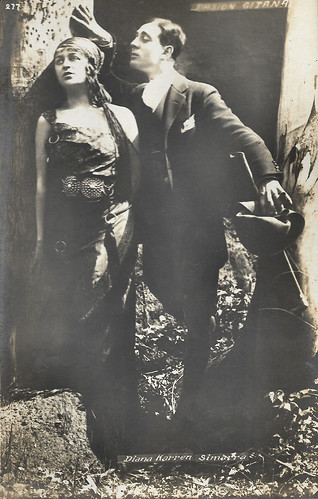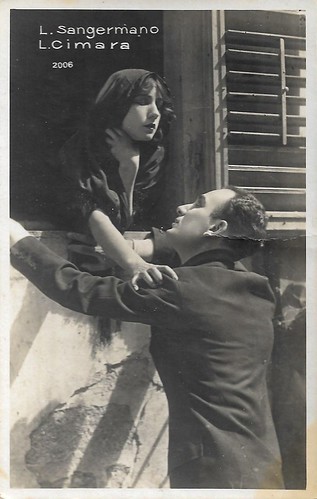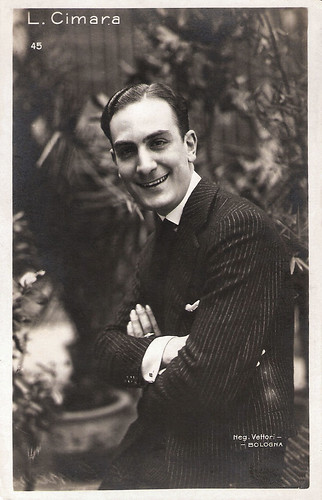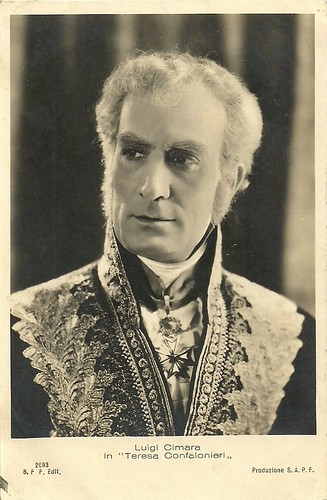
Italian postcard, no. 981. Photo: Vettori, Bologna. Giovanni Cimara.

Italian postcard, no. 103. Photo Vettori, Bologna. Luigi Cimara.
.

Spanish postcard, no. 277. Diana Karenne and Giovanni Cimara in Passione tsigana/Gypsy Passion (Ernesto Maria Pasquali, 1916). This film was Karenne's debut in Italian silent cinema.

Italian postcard by G. Vettori, Bologna, no. 2006. Lucy Di San Germano and Luigi Cimara acted twice together, in ...E dopo? (Febo Mari, 1918) and La rupe tarpea (Gaston Ravel, 1920).
Giovanni Cimara
Giovanni Cimara was born in 1889 in Rome, into an aristocratic family. His father Giuseppe Cimara was First Noble Guard at the Vatican. Giovanni's younger brother was the much more famous Luigi Cimara. Giovanni had an unfortunate start as a young actor but he was subsequently able to make up for himself by getting a first engagement from the great Ermete Zacconi. He then moved to the company of Dina Galli.
Giovanni was also very active in silent cinema. He got a contract with the production company Latium and he made his film debut in 1913. He was later appreciated as the protagonist of films produced by the production companies Pasquali Film and Edison Film. From 1918 he worked for Ambrosio Film and from 1921 for Silentium Film and Rodolfi Film. At that time he appeared in important and very successful films such as Gli spazzacamini della Val D'Aosta/The Chimney Sweeps of the Valley of Aosta (Umberto Paradisi, 1914), La disfida di Barletta/Ettore Fieramosca (Umberto Paradisi, 1915-1916) with Cimara in the title role, and Passione tsigana/Gypsy Passion and La contessa Arsenia/Countess Arsenia, both starring Diana Karenne and directed by Ernesto Maria Pasquali in 1916.
Cimara also acted in the lost Futurist film Perfido incanto/Perfidious enchantment (Anton Giulio Bragaglia, 1918) with Thais Galitzky and Ileana Leonidoff. From the late 1910s, Cimara also acted opposite such popular actresses as Lina Millefleurs, Lucy Di San Germano, Linda Pini, Maria Roasio, and Mercedes Brignone. By 1922 he quit his prolific film career, and only returned once for the Diana Karenne vehicle, La vena d'oro/The gold vein (Guglilemo Zorzi, 1928). Between 1918 and 1921 he had played in 20 Italian silent films.
In the 1930s, he entered EIAR where he became a renowned radio actor in a period in which prose through the radio was very popular. In 1933 he was Lisandro in 'A Midsummer Night's Dream' by William Shakespeare directed by Max Reinhardt. In the cast were also Carlo Lombardi, Cele Abba, Nerio Bernardi, Rina Morelli, Sarah Ferrati, Luigi Almirante, Memo Benassi, and Evi Maltagliati and they performed in the Boboli Gardens. He was also Sinibaldo in the world premiere of 'La rappresentazione di Santa Uliva' (The representation of Santa Uliva) in the Great Cloister of the Basilica of Santa Croce in Florence with Morelli, directed by Jacques Copeau. In 1940 he was hired to play himself in the film Ecco la radio!/Here's the radio! (Giacomo Gentilomo, 1940).
After the war, Cimara continued to work assiduously on the radio. He also acted with the Company of the Teatro Comico Musicale in Rome directed by Riccardo Mantoni. From 1946, Cimara became an acting teacher at the Libera Accademia d'Arte in Turin, and from time to time, he appeared in secondary roles in films, including Catene invisibili/Invisible chains (Mario Mattoli, 1942) and Lo scapolo/The Bachelor (Antonio Pietrangeli, 1955), next to Alberto Sordi. Incidentally, Cimara also returned to work in the theater. Giovanni Cimara died in 1970 in Rome. He married twice, first with the radio actress Lina Franceschi, then with Paola Fiorentini.

Italian postcard. Photo: Pasquali Film. Giovanno Cimara in La disfida di Barletta/Ettore Fieramosca (Umberto Paradisi, 1915). Caption: In the name of the Italian armies, Ettore Fieramosca (Giovanni Cimara) challenges (the Spanish) Baron la Motta, who has insulted Italy.

Italian postcard. Photo: Pasquali Film. Giovanno Cimara and Laura Darville (left) in La disfida di Barletta/Ettore Fieramosca (Umberto Paradisi, 1915). Caption: Zoraide saves Fieramosca, sucking the venom of the wound, and dies.

Italian postcard, no. 983. Photo: Vettori, Bologna. Giovanni Cimara.

Italian postcard, no. 1042. Photo: Vettori, Bologna. Luigi Cimara.

Italian postcard, no. 45. Photo: Vettori, Bologna. Luigi Cimara.
Luigi Cimara
Luigi Cimara was born in 1891, in Rome. He studied acting at the Accademia di Santa Cecilia in Rome, having Virginia Marini as a teacher. He made his stage debut in the company of Amedeo Chiantoni, highlighting himself as a young actor for his slim and lean, elegant and slender body. Subsequently, in the 1913-1914 season, he joined Lyda Borelli's company and, from 1915 to 1921, he was hired by the company of Armando Falconi and Tina Di Lorenzo as the jeune premier. He then passed to the company of Dario Niccodemi, forming a close-knit couple with Vera Vergani.
The real turning point came in 1931 when he finally got his own company, the famous Tofano-Merlini-Cimara company. The 1930s were years of great satisfaction for Cimara because first, in 1934, he was the stage companion of Kiki Palmer, then, in 1935, he was the manager in the company of Laura Adani and Umberto Melnati. He later acted in 1937 with Paola Borboni and, in 1939-40, with Evi Maltagliati and Carlo Ninchi.
At the end of the Second World War, Cimara had Lilla Brignone next to him in the 1946-1947 season and later, in the 1948-1949 season, he acted with Sarah Ferrati. In 1950-1951 he formed the Cimara-Paul-Ferro company, and, in 1951-1952, the Gioi-Cimara-Bagni company, which staged an amusing performance of André Roussin's 'La cicogna si diverte'. He was then partner of Anna Magnani, in 1953, in the last revue in which the actress played, and, in 1954, he was the partner of Enrico Maria Salerno and of the debutante Anna Maria Guarnieri in a very successful comedy, 'Quando la luna è blu' (The Moon is Blue) by Frederick Hugh Herbert, which Cimara also directed. In 1955 he was among the interpreters of a memorable 'Cherry Garden' directed by Giorgio Strehler.
His distinct aplomb earned him the nickname "Lord Brummell of the Italian theatre" of which he remained a true protagonist until his death. However, since the days of silent film, he was also active in cinema. He started at the Pasquali company in L'esplosione del forte B.2/The Explosion at Fort B2 (Umberto Paradisi, 1914). After various minor films during the mid-1910s, Cimara was paired with various Italian divas from the late 1910s onward. He co-starred opposite Helena Makowska in Caino/Cain (Leopoldo Carlucci, 1918), opposite Diomira Jacobini in L'autunno dell'amore/The autumn of love (Gennaro Righelli, 1918), opposite Lucy Di San Germano in ...E dopo?/...And then? (Febo Mari, 1918) and La rupe tarpea/The Tarpeian cliff (Gaston Ravel, 1920), and opposite Mercedes Brignone in La lotta per la vita/The struggle for life (Guido Brignone, 1921).
Then in sound cinema, he was employed as an important character actor in the 1930s, 1940s, and 1950s. He played the director of the telephone company in the comedy La telefonista/The telephone operator (Nunzio Malasomma, 1932) starring Isa Pola. He was Prince Metternich in Teresa Confalonieri/Loyalty of Love (Guido Brignone, 1934) with Marta Abba in the title role. He played the lawyer in the comedy Gli ultimi giorni di Pompeo/Pompey's last days (Mario Mattoli, 1937). And he was the first husband in the romantic comedy Dora Nelson (Mario Soldati, 1939) starring Assia Noris. Cimara often played aristocrats in comedies. Memorable was his role as a pedestrian invested in the comedy Cinque poveri in automobile/Five poor people in a car (Mario Mattoli, 1952). Cimara also worked for television and radio in several dramas and comedies. Luigi Cimara died in 1962 in Rome. He was 70.

Italian postcard by B.F.F.(Ballerini & Fratini, Firenze), no. 2581.

Italian postcard by B.F.F. Edit. (Ballerini & Fratini, Firenze), no. 2693. Photo: Produzione S.A.P.F. Luigi Cimara as Prince Metternich in the Italian historical film Teresa Confalonieri/Loyalty of Love (Guido Brignone, 1934).

Italian postcard by Ed. Fotocelere. Photo: Candiani. Luigi Cimara and Vivi Gioi in the stage play 'Non c'è pace per l'antico fauno' (There is no peace for the ancient faun) by Carlo Terron, which premiered on 7 November 1952 at the Teatro di Via Manzoni in Milan. It was performed by the Gioi-Cimara stage company, and directed by Daniele D'Anza.
Sources: Vittorio Martinelli (Il cinema muto italiano - Italian), Wikipedia (Italian), and IMDb.
No comments:
Post a Comment